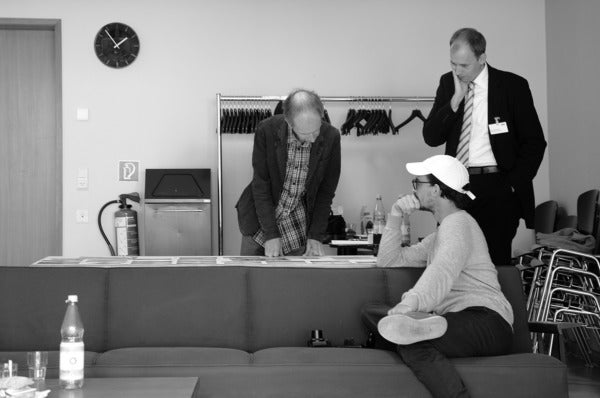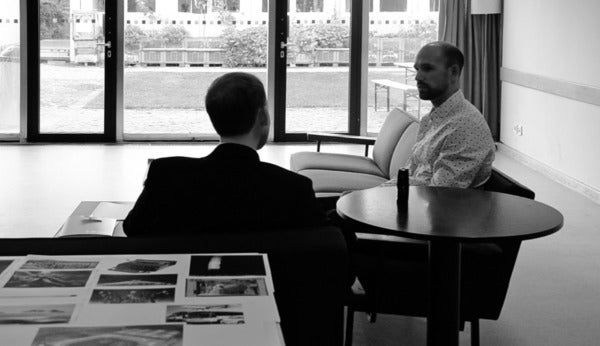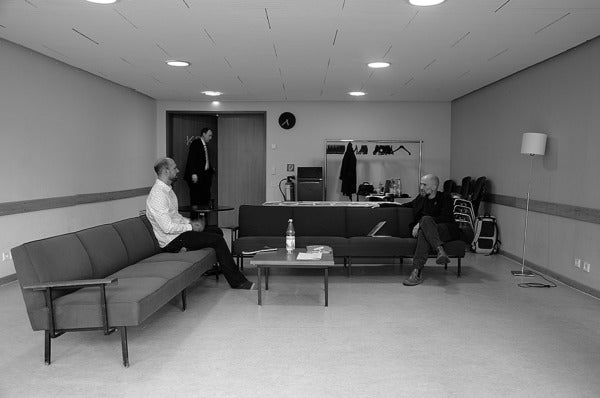
Jamie Allen, Paul Boshears, Bernhard Garnicnig, and Nina Jäger are co-editors of continent., a “media agnostic” online journal. We discussed para-academic publishing, “digital objects,” and many other aspects of their three-year-long collaboration with Haus der Kulturen der Welt (HKW), Technosphere.
Bojana Ginn: Tell us about your publication.
Continent: continent. is a collective, open access, Creative Commons-licensed para-academic organization. We are creating a platform for people to express ideas in many forms: text, image, sound, video — anything publishable online. We publish materials that address a wide swath of the human experience and scholarship, from philosophical essays to poetry in translation, to artistic dossiers. We are especially interested in scholarly materials that engage the affordances provided by publishing online, and the offline cultures and events subtended by these networks and communities.
We are a kind of confederacy of like-minded, big-hearted people living in various parts of Europe and North America, and we work together, mostly on the Internet. continent. is our labor of love and it has been the hard-won product of mutual support and trust among a group of people who understand that the best of scholarship, art-making, and media is a product of this kind of love, support, and trust. Although some of us have institutional affiliations and academic backgrounds, continent. is itself unaffiliated with any particular institution. In addition to publishing the regular issues of the journal, we have been collaborating with the developer community to modify the Open Journal Systems platform, and have partnered with more traditional cultural and academic bodies on events and conferences.
Our aim is to model an alternate way of building a thought community, removed from the ubiquity of profit motive and the heartaches and headaches that have plagued scholarly industries and communities for the past 50 years, reaching fever pitch in the last 10. What would scholarship look like if it were performed in a spirit of generosity and warmth, conversation and friendship? We welcome you to find out with us.
BG: Currently, you are collaborating with Berlin’s Haus der Kulturen der Welt (HKW) on a 3 year long international project named Technosphere. How did the collaboration come about?

Continent: There are several ways to answer that question … But, probably the most straightforward is to say that Jamie Allen (from continent.) and Bernard Dionysius Geoghagen (from HKW’s Technosphere team) had a conversation about the potentials of publishing in the way that we do — as a friendly collective, as a beyond-text initiative, and as a way of sidestepping the many, many inefficiencies and lags introduced by more traditional publishing outputs and channels. It was only a little later that we got the invitation from HKW to join the first event of the Technosphere Research Project in Berlin in October. This has been an invitation, essentially, to engage with their events, invited participants and research groupsthrough the excellent encounters the HKW has planned and put together. The collaboration is based on our shared values, especially around generosity and understanding the affective quality of discussions, lectures, and workshop. We are also all interested in experimental formats, ways of surmounting “tl;dr” (“too long; didn’t read”) problems for important discourses and topics, and the interface between “the academy” and its presumed “publics.”
We will publish a Technosphere, Now special issue of continent. just before the next Technosphere event occurs in April 2016. We’ll then be joining HKW in April for its next Campus event about the Technosphere and we’re excited to intervene in and trace the interactions taking place during these exciting seminars and work-groupings.
BG: How would you describe Technosphere?
Continent: The term “technosphere,” as we have been discussing it in the last year, is most directly related to the hypotheses advanced by the geologist and environmental engineer Peter K. Haff from Duke University.
In order to understand what Haff is suggesting, we should reflect on the various “-spheres” that describe the ways in which the planet evolves: the “atmosphere” describes the circulation of gases around our planet, the “lithosphere” describes the movement of the upper crust of the Earth’s surface, the “magnetosphere” describes the interactions of charged particles as they come into contact with a planet’s magnetic field, the “hydrosphere” describes the movement of water throughout the Earth’s surface — each of these -spheres interacts with the others and with the “biosphere,” the living systems of our vibrant Earth.
Haff has been suggesting that, in addition to these more familiar -spheres, we ought to include a previously ignored element contributing to the evolution of the planet: the role played by those things often called technological. The “technosphere” describes the movement and mobilization of the planet’s potential energy reserves. Just as a concept like “the biosphere” can seem to be all-encompassing, so too the technosphere touches on just about any aspect of the planet.
BG: What are the dilemmas of this project?
Continent: The first dilemma is probably at the front of most readers’ minds: why bother with a new term if its dimensions and definition are amorphous and hazy? As one starts to form an answer to that question, it becomes more apparent that the technosphere isn’t just a new term for talking about the Internet, or nuclear power, or nanotechnology. Rather, the technosphere is referring to the entire spectrum of tool use, or even “earth-use”: from stone tools that enabled hominids to clear land — to the use of language to teach other hominids how to enhance those stone tools — to the use of fire, which is a second stomach that enables humans to eat a broader range of substances, and also a tool for clearing land. These technologies enabled early humans to genetically engineer existing animals, affording their domestication. Domesticated animals led then to the bioengineering of cheese and fermented grain. Here we begin to get a sense of scope. Of course, tool use is not solely a matter of hominid evolution; other primates use stone tools, cetaceans appear to have sophisticated languages, birds use sticks, and so on. This perhaps underlines the posited presence of a “technological layer” of earthly existence.
It would appear that this technological agency is fundamental to particular kinds of sustainable replication on this planet. We might speculate that the first instance of the technosphere at work was at the point when a first mitochondria entered a first eukaryotic cell. Rather than restricting our understanding of technology to tool use and the attendant problems of agency that come with that analysis, the technosphere puts energy extraction, exhaustion, and recycling at the forefront. The current imbalanced rapaciousness of that which comprises the technosphere appears to be threatening the more balanced “natural” functioning of the other -spheres. The atmosphere is polluted, the hydrosphere is contaminated, and the biosphere oscillates between under- and over-compensation.

BG: What is, in your opinion, a cultural impact of Technosphere?
Continent: That’s a great question, and it’s one that HKW will be investigating for the next few years, bringing in dozens of experts from the sciences, the humanities, and the arts to discuss. It is precisely this kind of cultural programming that, we think, makes HKW such an important institution. It’s well and good to have consensus conferences among scientists and policymakers, but those conversations are anemic without a robust dialogue with extra-disciplinary and more generalized, cross-cutting cultural expertise.
There is much discussion these days of whether or not the Earth has entered a new geological era, the Anthropocene. HKW has spent some time exploring the implications of this Anthropocene concept and from that research the current Technosphere research project was born. This discussion is in part prompted by the accumulating evidence of global climate change that is impacting how human societies function today. Among the reservations some have to the concept of the Anthropocene is that the term emphasizes the agency of (particularly Western) humans too strongly and thus ignores more fundamental dimensions of how the Earth evolves over time, or authorizes its further exhaustion as a standing resource. Haff’s concept of the Technosphere is not precisely antagonistic to the Anthropocene, but does provide a way of reorienting the conversation away from arguments about humans as the primary actors of a global climate change. Peter Haff put it pretty drastically in our interviews with him: “We are not operating the Technosphere, the Technosphere is operating on us.” The impact of this way of thinking ought not be underestimated. It means we must question our previously held certainties about nature and the natural conditions we have grown accustomed to. What is our nature? What is our role on the planet? Is thinking in this a way a means to avoid taking responsibility for our actions? To say it is not our fault, just the result of our nature? Discussing, questioning, and revising the terms of the discussion becomes crucial, as our language is full of oppositional assumptions about “natures” and “cultures,” “objects” and “subjects.” There is necessarily the need for a discussion of the ethical consequences that follow from this new understanding of the -spheres in which we live and act. The knowledge and awareness that this research program aims to bring forward feels very necessary to us, because it may point to means of finding more conscious, responsible ways of thinking and acting.
BG: How do you use technology to create new forms of publishing?
Continent: continent.’s code editor, Bernhard Garnicnig, has been modifying the Open Journal Systems (OJS) platform for the last five years. We chose OJS at the time because it is an Open Source community for academic publishing and content management systems. OJS is in some ways the WordPress of academic publishing.
We are very curious to understand what publishing can be. Since the Gutenberg period, a journal has been a printed object circulated among people. And that hasn’t really changed much in these hundreds of years, even as we consider the concretized “digital object that is the PDF. In part, it hasn’t changed because something about it works, obviously. But the medium limits the kinds of outputs possible for communicating the work done. How does an article that is concerned with moving pictures, for example, illustrate its point? With text and still images. Online, of course, an author can elect to embed moving images into the text. But, in the main, digital publishing has meant making, essentially, a copy of what the printed article would look like, but rendered onto the reader’s screen — a flatter journal. We think there’s a missed opportunity here, and continent. was created partially in the spirit of challenging those publishing conventions.
BG: What do you think of the cybernation of publishing?
Continent: That’s a really interesting question that is significant to the ethos informing how continent. does what it does in the current academic environment. What you’re asking about is the deployment of “robo journals,” wherein there are no humans reading or publishing articles submitted to these journals that purport to put out high-quality research. Five years ago, when we began continent., these journals were creating a lot of mistrust about digital scholarship and academic publishing online. In the last year or so, there has been much more attention paid to the exploitative ways in which academic publishing operates (whether robots or humans, or neither, are reading the articles and publishing them).
We think that scholarly publishing needs to be reimagined. What does it mean to publish something? The typical understanding of the word suggests that some object is made knowable by a generic public — publishing as opposed to, say, keeping private. The assumption is that a generic public exists and objects of knowledge can circulate among that public. Continent. has been a platform for exploring what a publication is.
We’ve been arguing that publics are not a pre-existing given but are created by the circulation of objects of knowledge. Publication, then, is the process of creating publics. The Anglo-American tradition of contract law is itself premised on this circulation. The technical term is a material consideration. Without the circulation of an object of value between two parties, no contract can be said to be in effect. If there is a social contract, then there must be a circulation of these objects between the parties. We feel an obligation to create these value-laden objects and to share them as broadly as we can with folks.
BG: What is your favorite Technosphere device?
Continent: Do we really have to choose just one? There are quite a few of us making the journal, hahaha….
Maybe we can use Peter Haff’s example, the refrigerator. In an interview from 2013, Haff was asked to explain how the technosphere impacts our daily lives, and he asked the interviewer to consider their relationship to their refrigerator. Haff’s broader point in this example is to also illustrate that the effects of the technosphere are bigger than the aggregate effects of a few humans. Some people might elect to turn off their refrigerator for a few days as a means of combating greenhouse gas emissions caused by the coal-burning power plant that supplies the electricity. But there can be no food supply today in North America without the use of refrigeration.




